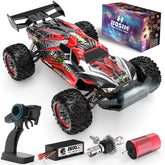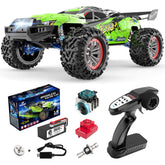My RC Car Says It’s Waterproof… Can I Submerge It?
So, you’ve just received a new RC car and it claims it’s “waterproof”. How trustworthy is that statement? Well, think of these “waterproof” claims as you would a company’s advertised internet speeds. Could it be waterproof? Sure! Will it be? Probably not. Most “waterproof” RC cars would be more accurately described as “splashproof”. You can run them through puddles or while it’s raining, but if you throw one in a pool, there’s about a 50% chance it will work afterward. Fortunately, it is possible to 99.9% waterproof an RC car, and that’s what we’ll be talking about today!
Why Water & RC Cars Don’t Mix
For obvious reasons, water and electricity don’t mix well. As such, you’ll need to take the proper precautions if you’re planning on running your electric RC in a wet environment. Even if your RC car is “waterproof” from an electrical standpoint, that alone doesn’t mean it will survive long-term! Water can also damage non-electrical components, cause parts to wear out faster, and even cause your car to lock up from excessive rust. Before we get to waterproofing the electronics in your car, we’ll go over the other preparation steps you should take before water exposure.
The key word here is “should”. Technically speaking, you don’t need to take any of these prep steps, but doing so will increase the longevity of your vehicle and reduce the number of parts you’ll need to replace. However, for some people, the extra time required (both for prep and aftercare) just isn’t worth saving a few dollars. Whether or not you want to complete the preventative maintenance is up to you, but we would recommend doing so.
Prepping Your RC for Water Exposure
This may surprise you, but you can also run RC vehicles that aren’t waterproof through the water. As long as the water never touches any electrical components (the ESC, the receiver, the servo, or bare wires), you can drive your vehicle through shallow water without issue. When doing so, make sure you drive slow! Speeding through water causes splashing, spraying, and waves, all of which could reach the electronics of your vehicle. Proceed at your own risk.
| Waterproofing Level | Maximum Water Exposure |
| Not Waterproof | Suitable for usage at low speeds through water that is below the RC’s electronics. Low-speed operation only. |
| Labeled as “Waterproof” | Suitable for low and high-speed operation through puddles and in the rain. Complete submersion is not recommended. |
| Completely waterproofed |
Suitable for low and high-speed operation through puddles and rain. Complete submersion is possible (though signal lossmay pose an issue). |
Regardless of the current waterproofing level of your RC vehicle, it’s recommended that you complete the preventative preparations below. These will protect your RC from unnecessary wear and tear.
Tires and Rims
It’s a fairly common practice for manufacturers to vent an RC vehicle’s wheels, either by creating a hole in the tire or through the rims themselves. Venting a tire is supposed to help prevent sand, dirt, and water from getting stuck inside of the tires (as well as prevent bouncing). However, if your wheels are vented from inside of the rim, any water that gets in there won’t be able to escape!
Unfortunately, leaving water inside of your tires will damage them, especially if they contain foams. The tires will end up imbalanced and the foams will begin to rot, ruining your tires! Fortunately, you can prevent this from happening by simply covering the holes with tape before driving your RC through the water.
Drivetrain
Part, if not all, of your RC’s drivetrain (gearbox, differentials, driveshafts, CVDs, bearings, bushings, etc.) is made from metal. Once exposed to water, these parts can begin to rust if not dried properly. You can help prevent this by lubricating the drivetrain with marine grease!
This waterproof type of grease is perfect for everyday use as well as in wet environments. Penetrating oil can be applied to exposed metal parts that can’t be greased (such as the dogbone shafts) to prevent rust from building up. Plastic components are already waterproof so they don’t require any treatment.
Batteries
The batteries themselves are completely fine being submerged. You won’t need to worry about them getting wet, but it may be worth treating them anyway. By applying some hot glue around the base of the cords (where they enter into the battery) casing, you can prevent water from getting inside of the hard casing. Soft case batteries are fine as is!
Motor
There are three types of motors: brushed, sensorless brushless, and sensored brushless motors. Brushed motors can be used in water without issue, although dirt, grime, and other contaminants in the water can cause them to fail prematurely. Consider covering the vents using pantyhose or a nylon sock when submerging the motor. This will keep the contaminants out, protecting your motor.
Sensorless brushless motors are already sealed so they can be used underwater as well. How long your motor lasts ultimately depends on how well it’s constructed: motors with apoor seal will leak faster and won’t be much good once the bearings fail. Still, sensorless brushless motors are considered to be suitable for aquatic environments.
Sensored brushless motors contain sensors inside of the motor casing. Once these get wet, the motor will stop working. We do not recommend submerging sensored brushless motors in water.
Water exposure will cause additional wear and tear on the bearings/bushings of your motor. You can remove the motor and re-grease the bearings/bushings after water exposure to help prolong the motor’s lifespan. However, depending on the cost of a replacement motor, it may be more time-efficient to simply accept the shorter lifespan. You’ll likely still get a decent life from your motor, although it will certainly be shorter than a water-free lifecycle.
Waterproofing Your RC
Now you know the basic prep for driving an RC car in the water, but what about actually waterproofing it? Well, it’s actually a fairly straightforward process! Here are the individual components you’ll need to consider when preparing your RC vehicle for complete submersion.
Servo
Your RC may have a non-waterproof or waterproof servo. As mentioned above, simply being labeled “waterproof” doesn’t guarantee it won’t fail underwater, but it significantly decreases the overall likelihood of water-related issues. Still, you can follow the steps below for added protection. They will work on any type of servo.
- Apply marine grease to the output spline. You can take the servo apart and apply the marine grease from the inside, or simply apply it from the exterior. Make sure any openings are filled with grease. This will prevent any water from leaking past the output spline. After these openings are sealed, apply a thick ring of grease around the output spline.
- Next, dip your servo in Plasti Dip. Since you’ve already applied a thick ring of grease around the output spline, you won’t need to worry about the Plasti Dip constricting your output spline once it dries. Still, try not to get any on the grease if possible, as this will need to be cleaned off later on. Focus on getting the servo body covered with Plasti Dip, coating the wire entrance, screw heads, and openings. With the grease protecting your output spline and the rest of the servo covered in Plasti Dip, your servo will be completely safe to use underwater!
ESC
The easiest option here is to simply purchase a waterproof ESC. However, if your ESC isn’t waterproof (or you just want to add an additional level of protection to your current ESC), it’s easy enough to do so. You’ll just need some conformal coating! That said, it’s important to note that conformal coating is both toxic and flammable. We recommend completing this process outdoors or in a well-ventilated area.
- Take the ESC board out of its casing (if applicable).
- Ensure your power switch/button is protected. If it doesn’t already have a rubber cover, you’ll need to make one. Make sure that you can still power on/off the ESCthrough the cover before proceeding to the next step. Alternatively, you can also solder the power switch wires together, leaving the ESC permanently turned on.
- Use a brush to cover the entire board with conformal coating. Once a layer is completed, give it some time to dry. The conformal coating will have a tint after it’s dried. We recommend applying a minimum of three layers of conformal coating onto the ESC board. Make sure that the entire board is covered for maximum protection.
- Reassemble the ESC inside of its casing.
Some vehicles use a 2-in-1 ESC/Receiver. This means that both components are part of a single board. If that’s the case for your RC, plug servo leads into all of the available channels then follow the steps listed above.
Receiver
It’s fairly rare (though not impossible) to find a waterproof receiver. Fortunately, waterproofing your own is extremely easy!
- Plug servo leads into every available channel.
- Dip the entire receiver into Plasti Dip, taking care to cover the casing and about ½ an inch up the antenna lead and servo leads. Make sure you do not get any Plasti Dip in the female ends of the servo leads. You won’t need to use all the channels later on if you don’t want to; they can get wet without issue, but want to avoid blocking them with Plasti Dip!
- Leave the receiver to drip-dry. The Plasti Dip should be dry after 30 minutes or so.
- Reinstall the receiver. Remember, 2.4GHz signals do not penetrate water very well. If you’re planning on fully submerging your RC then you’ll want to place the receiver as high as possible for optimal signal underwater. 27MHz and 49MHz receivers/transmitters are more effective for underwater transmissions.
Aftercare
After running your vehicle through water, it’s a good idea to clean and dry it. Not everyone does this, but not doing so will cause your RC’s components to fail sooner. Skip these recommendations at your own risk.
- Teardown your RC. This process involves disassembling your entire RC. Once disassembled, you will be able to remove water, dry the vehicle, and regrease the vehicle easier.
- Regrease the drivetrain system. This may not be necessary if you’ve been using marine grease, although you should still re-grease your drivetrain on occasion.
- Treat non-contact metal parts (like dogbone shafts or frame rails) with penetrating oil or WD-40. This will prevent rust from forming.
At a bare minimum, you should dry your RC before storing it away. Shake out any excess water, then dry the vehicle using an air compressor. Even this minimal level of effort will contribute greatly to the overall longevity of your favorite RC vehicle!
Summary
There are many different methods you can use to waterproof your vehicle. While waterproofing will prevent instant electrical failure, simply using your vehicle in water will cause additional wear and tear to the RC over time. If you’re trying to get the longest possible use out of your RC (before replacing parts), then driving in the water is best avoided. However, for many people, the additional wear is worth the added entertainment and driving opportunities. So, are you going to waterproof your RC? The choice is up to you!
By Kevin Foley





















































































































Leave a comment
Please note, comments need to be approved before they are published.